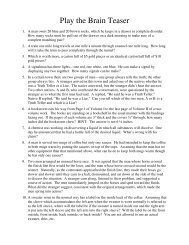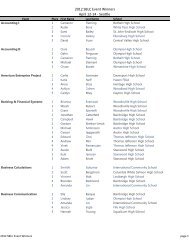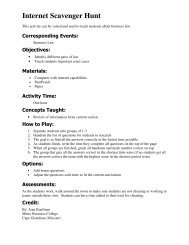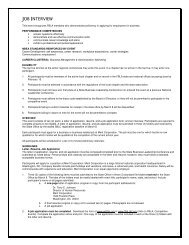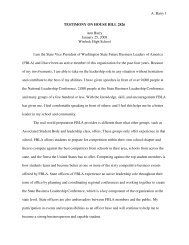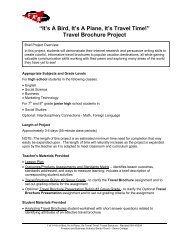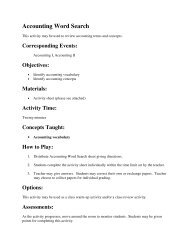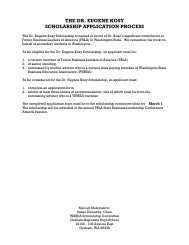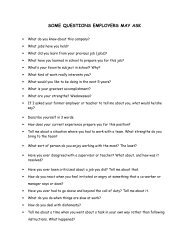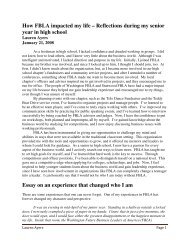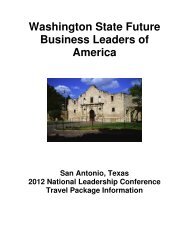“Deals on Wheels†Car Loan Project
“Deals on Wheels†Car Loan Project
“Deals on Wheels†Car Loan Project
Create successful ePaper yourself
Turn your PDF publications into a flip-book with our unique Google optimized e-Paper software.
“Deals <strong>on</strong> Wheels!”<br />
<strong>Car</strong> <strong>Loan</strong> <strong>Project</strong><br />
Brief <strong>Project</strong> Overview:<br />
In this project students will learn about budgets, car purchasing, and using credit. They will<br />
calculate m<strong>on</strong>thly car payments including tax and license fees, vehicle trade-in and down<br />
payments. While this less<strong>on</strong> is intended to educate the c<strong>on</strong>sumer, and thus all students, there<br />
are many career opportunities related to the field of finances. Perhaps this will get students<br />
thinking about <strong>on</strong>e.<br />
Appropriate Subjects and Grade Levels<br />
For high school students in the following classes:<br />
• Ec<strong>on</strong>omics<br />
• Accounting<br />
• Business C<strong>on</strong>cepts<br />
• Business Law<br />
• Business Math<br />
• Financial Records<br />
Length of <strong>Project</strong><br />
One 55-minute class period; Handout #3 could be c<strong>on</strong>tinued as homework assignment<br />
• Opti<strong>on</strong>al— <strong>on</strong>e additi<strong>on</strong>al 55-minute class period for job descripti<strong>on</strong> & role-play assignment<br />
• Opti<strong>on</strong>al— <strong>on</strong>e additi<strong>on</strong>al 55-minute class period for guest speaker, job descripti<strong>on</strong> & role play<br />
NOTE: The length of this project is an estimated minimum time need for completi<strong>on</strong> that may easily<br />
be expanded up<strong>on</strong>. The length of time will naturally increase as the project is expanded up<strong>on</strong> by the<br />
teacher as it is adapted to meet classroom and curriculum goals.<br />
Teacher’s Materials Provided<br />
• Deals <strong>on</strong> Wheels Less<strong>on</strong> Plan<br />
• Outcomes/Products Assessments and Standards Matrix – identifies less<strong>on</strong> outcomes, standards<br />
addressed, and ways to measure learning; brief descripti<strong>on</strong>s of corresp<strong>on</strong>ding student activities<br />
• Calculating Amount to Be Financed/Borrowed— may be used as a blank overhead to dem<strong>on</strong>strate<br />
completi<strong>on</strong> of student worksheet<br />
• Calculating Amount to Be Financed/Borrowed Sample Teacher Overhead—overhead master with<br />
sample calculati<strong>on</strong> already filled in<br />
• Calculating Amount of M<strong>on</strong>thly Payment, Total Finance Charge and Total Cost of <strong>Loan</strong>— may be<br />
used as a blank overhead to dem<strong>on</strong>strate completi<strong>on</strong> of student worksheet<br />
• Calculating Amount of M<strong>on</strong>thly Payment, Total Finance Charge and Total Cost of <strong>Loan</strong> Answer<br />
Key<br />
• Budget & Pie Chart Rubric – clarify Budget & Pie Chart assignment requirements and assessment<br />
criteria<br />
1 of 20 “Deals <strong>on</strong> Wheels” <strong>Car</strong> <strong>Loan</strong> <strong>Project</strong> - Revised 09/14/2004<br />
Finance and Business Industry Sector Grant – Sierra College
• Budget Essay Rubric— clarify Budget Essay assignment requirements and assessment criteria<br />
• Opti<strong>on</strong>al additi<strong>on</strong>al activity materials listed below<br />
Student Materials Provided<br />
• Calculating Amount to Be Financed/Borrowed Student Copy—worksheet for calculating car loan<br />
amounts<br />
• Calculating Amount of M<strong>on</strong>thly Payment, Total Finance Charge and Total Cost of <strong>Loan</strong>—<br />
worksheet for calculating m<strong>on</strong>thly car payments<br />
• Creating a Budget—assignment instructi<strong>on</strong>s<br />
• Budget and Pie Chart Rubric— clarify Budget & Pie Chart assignment requirements<br />
• Budget Essay Rubric— clarify Budget Essay assignment requirements<br />
• Opti<strong>on</strong>al follow-up activity materials listed below<br />
Classroom Facilities Needed<br />
• Computer/printer for students<br />
• Internet access<br />
• Word, Excel, Publisher (opti<strong>on</strong>al)<br />
• Overhead projector<br />
Student Supplies Needed<br />
• Calculators<br />
• Floppy disk<br />
Teacher’s Preparati<strong>on</strong> Checklist<br />
• Review Outcomes/Products and Assessments Matrix, Less<strong>on</strong> Plan, student materials and<br />
perhaps the recommended background materials<br />
• Practice following the student’s exercise directi<strong>on</strong>s<br />
• Make <strong>on</strong>e copy of each handout per student:<br />
o Calculating Amount to be Financed/Borrowed Student Copy<br />
o Calculating Amount of M<strong>on</strong>thly Payment, Total Finance Charge and Total Cost of <strong>Loan</strong><br />
o Creating a Budget<br />
o Budget and Pie Chart Rubric<br />
o Budget Essay Rubric<br />
• Gather calculators and floppy disks<br />
Recommended Background Materials<br />
• No-Brainers <strong>on</strong> Buying a New <strong>Car</strong> (1998) video<br />
• The Insiders Guide to Buying a New or Used <strong>Car</strong> book by Burke Le<strong>on</strong>, Stephanie Le<strong>on</strong><br />
• <strong>Car</strong> Secrets Revealed book by Corey Rudl<br />
2 of 20 “Deals <strong>on</strong> Wheels” <strong>Car</strong> <strong>Loan</strong> <strong>Project</strong> - Revised 09/14/2004<br />
Finance and Business Industry Sector Grant – Sierra College
Opti<strong>on</strong>al: Follow-up Activities<br />
• Financing Practice Problems Student Copy, Financing Practice Problems Answer Key<br />
• <strong>Loan</strong> Agent Interview<br />
• Create a Job Descripti<strong>on</strong> from the interview results, Job Descripti<strong>on</strong> for a <strong>Car</strong>eer in Finance Rubric<br />
• Role play the process of obtaining a loan depicting current interest rates, what rates students<br />
could qualify for, and how a pers<strong>on</strong> could qualify for the lowest rate possible (using informati<strong>on</strong><br />
obtained from the interview)<br />
• Invite a guest speaker from a car dealership’s finance department<br />
“Deals <strong>on</strong> Wheels” <strong>Car</strong> <strong>Loan</strong> <strong>Project</strong><br />
Written and Edited by:<br />
Beth Islip<br />
Susan Espana<br />
Kay Fegette<br />
Jeanne Samps<strong>on</strong><br />
Mike Walker<br />
Sierra Community College developed and produced the Business Industry Sector Grant for Finance<br />
and Business. Funding provided by the <strong>Car</strong>l D. Perkins Vocati<strong>on</strong>al and Technical Educati<strong>on</strong> Act of<br />
1998 through the California Department of Educati<strong>on</strong>.<br />
For more informati<strong>on</strong> please visit: FAB.SierraCollege.edu<br />
3 of 20 “Deals <strong>on</strong> Wheels” <strong>Car</strong> <strong>Loan</strong> <strong>Project</strong> - Revised 09/14/2004<br />
Finance and Business Industry Sector Grant – Sierra College
Outcomes/Products, Assessments and Standards Matrix<br />
“Deals <strong>on</strong> Wheels!” <strong>Car</strong> <strong>Loan</strong> <strong>Project</strong><br />
Learning<br />
Outcome/Products<br />
Calculate amount to<br />
be financed/borrowed<br />
after tax and license<br />
fees, vehicle trade-in<br />
and down payment.<br />
Calculate m<strong>on</strong>thly car<br />
payment, total<br />
finance charge and<br />
total cost of loan<br />
using various rates of<br />
interest and length of<br />
loan using a<br />
calculator and Web<br />
Site <strong>Loan</strong> Calculator.<br />
Design a pers<strong>on</strong>al<br />
budget that shows<br />
m<strong>on</strong>thly income and<br />
fixed and flexible<br />
expenses, as well as<br />
totals for each<br />
secti<strong>on</strong>. Create a pie<br />
chart to illustrate the<br />
Assessment<br />
• Complete Calculating Amount to Be<br />
Financed/Borrowed worksheet.<br />
• Opti<strong>on</strong>al: Complete Financing Practice Problems<br />
worksheet.<br />
Mastery will be determined by accuracy of informati<strong>on</strong>.<br />
Calculating Amount to Be Financed/Borrowed sample<br />
teacher overhead and Financing Practice Problems<br />
Answer Sheet provided.<br />
• Complete Calculating Amount of M<strong>on</strong>thly Payment,<br />
Total Finance Charge and Total Cost of <strong>Loan</strong><br />
worksheet.<br />
• Discuss pros and c<strong>on</strong>s of different interest rates and<br />
terms of loan and the impact these have <strong>on</strong> a<br />
pers<strong>on</strong>’s m<strong>on</strong>thly budget.<br />
• Brainstorm as a class ways a pers<strong>on</strong> could qualify for<br />
lower rates of interest.<br />
Calculating Amount of M<strong>on</strong>thly Payment, Total Finance<br />
Charge and Total Cost of <strong>Loan</strong> Answer Key provided.<br />
• Create an Excel spreadsheet budget (Creating a<br />
Budget) that shows m<strong>on</strong>thly income and fixed and<br />
flexible expenses, as well as totals for each secti<strong>on</strong>.<br />
Chart the findings using a pie chart—include labels<br />
and percentages. Budget and Pie Chart Rubric<br />
provided.<br />
Scoring: A Rubric (provided) that rates the title, data<br />
accuracy and organizati<strong>on</strong>, readability, data<br />
Level of Bloom’s<br />
Tax<strong>on</strong>omy<br />
Knowledge<br />
Knowledge<br />
Knowledge<br />
Comprehensi<strong>on</strong><br />
Evaluati<strong>on</strong><br />
Analysis<br />
Synthesis<br />
Standards Assessed<br />
Business Core<br />
1.6 Informati<strong>on</strong> Technology<br />
1.6.1 Applicati<strong>on</strong>s<br />
1.6.10 Telecommunicati<strong>on</strong>s<br />
2.0 Accounting & Finance<br />
2.1.3 Cash Management<br />
2.1.6 Ethics<br />
2.2 Financial Analysis<br />
2.2.1 Credit Analysis<br />
2.2.4 Financial Resp<strong>on</strong>sibility<br />
Language Arts 9/10<br />
Reading Comprehensi<strong>on</strong> 2.6<br />
Ec<strong>on</strong>omics<br />
12.5.3 Interest Rates & Relative<br />
Significance<br />
Business Core<br />
1.6 Informati<strong>on</strong> Technology<br />
1.6.1 Applicati<strong>on</strong>s<br />
1.6.2 Computer Operati<strong>on</strong>s<br />
1.6.5 Informati<strong>on</strong> Resources<br />
1.6.7 Problem Solving<br />
2.2 Financial Analysis<br />
2.2.1 Credit Analysis<br />
2.2.4 Financial Resp<strong>on</strong>sibility<br />
2.2.10 Technology<br />
Language Arts 9/10<br />
Reading Comprehensi<strong>on</strong> 2.1, 2.6<br />
Listening Strategies 2.3<br />
Writing Strategies 1.8<br />
Business Core<br />
1.1 Business Communicati<strong>on</strong>s<br />
1.1.1 Diversity<br />
1.1.2 Effectiveness<br />
1.1.6 Oral Communicati<strong>on</strong>s<br />
1.6 Informati<strong>on</strong> Technology<br />
1.6.1 Applicati<strong>on</strong>s<br />
4 of 20 “Deals <strong>on</strong> Wheels” <strong>Car</strong> <strong>Loan</strong> <strong>Project</strong> - Revised 09/14/2004<br />
Finance and Business Industry Sector Grant – Sierra College
findings.<br />
Illustrate how budgets<br />
influence the choices<br />
<strong>on</strong>e can make in<br />
purchasing a vehicle<br />
using credit.<br />
Opti<strong>on</strong>al:<br />
Identify the<br />
requirements for<br />
becoming a <strong>Loan</strong><br />
Officer/ Agent.<br />
interpretati<strong>on</strong>, neatness and attractiveness.<br />
• Estimate m<strong>on</strong>ey available for a m<strong>on</strong>thly car payment<br />
and calculate the highest dollar amount that could be<br />
financed/borrowed.<br />
• Using the Internet, research two vehicles student is<br />
interested in purchasing, as well as current interest<br />
rates and loan terms.<br />
• Write a 5-paragraph essay describing how budgets<br />
influence the choices <strong>on</strong>e can make in purchasing a<br />
car using credit. Include what vehicle was chosen to<br />
purchase. One may choose to buy a car not using<br />
credit and seek an alternative choice (use m<strong>on</strong>ey in<br />
savings account).<br />
• Using both the budget and the informati<strong>on</strong> from the<br />
two vehicles and loan packages researched; build a<br />
case for the choice made.<br />
Scoring: Budget Essay Rubric provided rates the clarity of<br />
topic, feasibility of ideas, sentence structure and correct<br />
usage of grammar.<br />
• Interview a <strong>Loan</strong> Agent using the <strong>Loan</strong> Agent<br />
Interview handout. Students should be prepared to<br />
share their findings with the class.<br />
• Create a job descripti<strong>on</strong> for the positi<strong>on</strong> of a <strong>Loan</strong><br />
Officer/Agent. <strong>Loan</strong> Officer Job descripti<strong>on</strong> Rubric<br />
provided.<br />
Scoring: Interview sheet is completely filled out. A Rubric<br />
(provided) for the Job descripti<strong>on</strong> includes ratings for<br />
complete informati<strong>on</strong>, “realness,” neatness, spelling and<br />
grammar.<br />
Evaluati<strong>on</strong><br />
Analysis<br />
Comprehensi<strong>on</strong><br />
Synthesis<br />
Analysis<br />
Evaluati<strong>on</strong><br />
Analysis<br />
Evaluati<strong>on</strong><br />
Knowledge<br />
Applicati<strong>on</strong><br />
Synthesis<br />
1.6.2 Computer Operati<strong>on</strong>s<br />
1.6.3 Document Processing<br />
1.6.7 Problem Solving<br />
2.2 Financial Analysis<br />
2.2.1 Credit Analysis<br />
2.2.4 Financial Resp<strong>on</strong>sibility<br />
2.2.10 Technology<br />
Language Arts 9/10<br />
Writing Strategies 1.1, 1.4, 1.5, 1.8<br />
Writing Applicati<strong>on</strong>s 2.3<br />
Written/Oral 1.1-1.5<br />
Reading 2.6<br />
Language Arts 11/12<br />
Writing Applicati<strong>on</strong>s 2.3<br />
Written/Oral 1.1-1.3<br />
Ec<strong>on</strong>omics<br />
12.1.1 Ec<strong>on</strong>omic C<strong>on</strong>cepts Need for<br />
Choices<br />
Business Core<br />
1.6 Informati<strong>on</strong> Technologies<br />
1.6.1 Applicati<strong>on</strong>s<br />
1.6.2 Computer Operati<strong>on</strong>s<br />
1.6.3 Document Processing<br />
1.6.5 Informati<strong>on</strong> Resources<br />
1.6.6 Presentati<strong>on</strong><br />
2.0 Accounting & Finance<br />
2.1.3 Cash Management<br />
2.2 Financial Analysis<br />
2.2.1 Credit Analysis<br />
2.2.4 Financial Resp<strong>on</strong>sibility<br />
2.2.10 Technology<br />
Language Arts 9/10<br />
Writing 1.3, 1.8, 2.3<br />
Language C<strong>on</strong>venti<strong>on</strong>s 1.2, 1.3, 1.4<br />
Business Core<br />
1.1 Business Communicati<strong>on</strong>s<br />
1.1.1 Diversity<br />
1.1.2 Effectiveness<br />
1.1.6 Oral Communicati<strong>on</strong>s<br />
5 of 20 “Deals <strong>on</strong> Wheels” <strong>Car</strong> <strong>Loan</strong> <strong>Project</strong> - Revised 09/14/2004<br />
Finance and Business Industry Sector Grant – Sierra College
Opti<strong>on</strong>al:<br />
Identify and<br />
dem<strong>on</strong>strate the<br />
steps of obtaining a<br />
vehicle loan and<br />
qualifiers for the<br />
lowest rates possible.<br />
• Interview a <strong>Loan</strong> Agent of choice to find out the steps<br />
in obtaining a vehicle loan. <strong>Loan</strong> Agent Interview<br />
handout provided.<br />
• In small groups, write a script for a role-play that<br />
illustrates the steps in obtaining a vehicle loan,<br />
current interest rates, what interest rates <strong>on</strong>e could<br />
currently qualify for, and how a pers<strong>on</strong> could qualify<br />
for the lowest rate possible.<br />
• Present the role-play to the class.<br />
Scoring: Interview sheet is completely filled out. Mastery<br />
for the Role Play Presentati<strong>on</strong> will be determined by<br />
depicti<strong>on</strong> of situati<strong>on</strong> and credibility of facts.<br />
Knowledge<br />
Comprehensi<strong>on</strong><br />
Applicati<strong>on</strong><br />
Language Arts 9/10<br />
Listening Strategies 1.8, 1.9, 2.3<br />
Language Arts 11/12<br />
Writing Strategies 1.1, 1.2, 1.5, 1.6<br />
Writing Applicati<strong>on</strong>s 2.1, 2.3<br />
Ec<strong>on</strong>omics<br />
12.5.3<br />
Business Core<br />
1.1 Business Communicati<strong>on</strong>s<br />
1.1.1 Diversity<br />
1.1.2 Effectiveness<br />
1.1.4 Methods of Communicati<strong>on</strong><br />
1.1.5 N<strong>on</strong>verbal Communicati<strong>on</strong><br />
1.1.6 Oral Communicati<strong>on</strong><br />
1.5 Employability Skills<br />
1.5.5 Positive Attitude<br />
1.5.6 Teamwork<br />
6 of 20 “Deals <strong>on</strong> Wheels” <strong>Car</strong> <strong>Loan</strong> <strong>Project</strong> - Revised 09/14/2004<br />
Finance and Business Industry Sector Grant – Sierra College
Less<strong>on</strong> Plan<br />
“Deals <strong>on</strong> Wheels!” <strong>Car</strong> <strong>Loan</strong> <strong>Project</strong><br />
A. Introducti<strong>on</strong>: (About 5 minutes)<br />
Address Students:<br />
How many of you own your own car? First car or sec<strong>on</strong>d car? Is this the car of your dreams?<br />
Whether or not you own your own car, think for a minute, “What is your dream car?” Close your eyes<br />
and picture yourself getting into the driver’s seat of your ideal car, putting the key in the igniti<strong>on</strong>,<br />
starting the car and driving down the street. But how can you afford the car of your dreams? How do<br />
you go about getting this car? Job? Win the lottery? Mom and Dad give you the m<strong>on</strong>ey? Take out a<br />
loan? Well, how much will that cost you??? Do you have good credit? How do you get credit? And<br />
<strong>on</strong>ce you get this car, how do you support it? These are all questi<strong>on</strong>s that we will be examining in this<br />
less<strong>on</strong>.<br />
B. Body:<br />
Topic Outline (About 5 minutes)<br />
Address Students:<br />
People borrow m<strong>on</strong>ey or use credit to purchase something in the present that will be paid for with<br />
future income. Borrowing increases the ability to purchase the things people want now, like a new<br />
car! A pers<strong>on</strong> who is c<strong>on</strong>sidered “credit worthy” is <strong>on</strong>e who is trusted to borrow <strong>on</strong>ly what he or she<br />
can repay. Before a pers<strong>on</strong> can make a big decisi<strong>on</strong> like buying and financing a new car, they must<br />
first analyze their m<strong>on</strong>thly income and expenses to figure out how much they can actually afford per<br />
m<strong>on</strong>th or explore the opti<strong>on</strong> of buying the vehicle “outright” without financing (using savings).<br />
The c<strong>on</strong>cept that “there is no such thing as a free lunch” means that there is a cost to every decisi<strong>on</strong>,<br />
whether m<strong>on</strong>etary or intrinsic. Good decisi<strong>on</strong>s require a clear understanding of alternatives. Students<br />
must learn to make choices am<strong>on</strong>g alternatives in order to use their income or resources wisely.<br />
In this less<strong>on</strong> you will learn:<br />
• How to calculate m<strong>on</strong>thly car payments using different rates of interest.<br />
• How to calculate the maximum amount that can be financed/borrowed given a preset<br />
estimated/budgeted m<strong>on</strong>thly payment.<br />
• How limited resources cause people to make choices.<br />
Teacher Activities (About 10 minutes)<br />
1. Dem<strong>on</strong>strate how to figure the total vehicle cost including tax and license fees, trade-in value, and<br />
down payment. Use Handout #1—Calculating Amount to be Financed/Borrowed Sample Teacher<br />
Overhead (students should have student copy).<br />
2. Discuss how the total amount to be financed (total cost of vehicle), different rates of interest, and<br />
length of car loan determine your m<strong>on</strong>thly car payments. Include in the discussi<strong>on</strong> the fact that<br />
students need to first determine how much they can afford per m<strong>on</strong>th towards a car as dictated by<br />
their m<strong>on</strong>thly budget (income minus existing expenses).<br />
7 of 20 “Deals <strong>on</strong> Wheels” <strong>Car</strong> <strong>Loan</strong> <strong>Project</strong> - Revised 09/14/2004<br />
Finance and Business Industry Sector Grant – Sierra College
3. Dem<strong>on</strong>strate how to use a <strong>Loan</strong> Calculator <strong>on</strong> the Internet (www.bankrate.com) to calculate<br />
m<strong>on</strong>thly car payments using various rates of interest and terms of loan.<br />
Student Activities (About 30 minutes)<br />
1. Have students complete Handout #2—Calculating Amount of M<strong>on</strong>thly Payment, Total Finance<br />
Charge and Total Cost of <strong>Loan</strong> using regular calculators and a <strong>Loan</strong> Calculator from<br />
www.bankrate.com.<br />
2. Go over results as a class. (Show Handout #2—Calculating Amount of M<strong>on</strong>thly Payment, Total<br />
Finance Charge and Total Cost of <strong>Loan</strong> Answer Key <strong>on</strong> overhead for students to quick-check<br />
answers) Clear up any questi<strong>on</strong>s.<br />
3. Discuss pros and c<strong>on</strong>s of different interest rates and terms of loan and the impact these have <strong>on</strong> a<br />
pers<strong>on</strong>’s m<strong>on</strong>thly budget. Brainstorm ways a pers<strong>on</strong> could qualify for lower rates of interest.<br />
4. Have students complete Handout #3—Creating a Budget. In this exercise students will 1)<br />
research two vehicles they would like to purchase; 2) calculate the m<strong>on</strong>thly payment, total finance<br />
charge and total cost of loan for each of the vehicles; 3) create a spreadsheet in Excel that shows<br />
their total m<strong>on</strong>thly income and fixed and flexible expenses; 4) chart their findings in a pie chart,<br />
including labels and percentages; 5) estimate what they could pay per m<strong>on</strong>th and calculate the<br />
highest dollar amount they could finance/borrow for the vehicles they have researched; 6) analyze<br />
their findings and write a 5-paragraph essay about: what vehicle they can afford to buy and why;<br />
which loan would they would take and why; which features make this loan more appealing than<br />
the others.<br />
C. Closure: (About 5 minutes)<br />
Address Students:<br />
It is very important to make sure that you can afford your m<strong>on</strong>thly car payment al<strong>on</strong>g with your living<br />
expenses and other expected expenses such as registrati<strong>on</strong>, insurance, maintenance and gas. D<strong>on</strong>’t<br />
forget to allow a buffer for unexpected expenses too.<br />
Good credit habits begin early. Repaying loans and returning borrowed items in good c<strong>on</strong>diti<strong>on</strong><br />
establish lifel<strong>on</strong>g patterns of resp<strong>on</strong>sibility. D<strong>on</strong>'t borrow what you can't repay - Be a resp<strong>on</strong>sible<br />
borrower who repays as promised, showing you are worthy of getting credit in the future. Before you<br />
borrow, compare your total payment obligati<strong>on</strong>s with income that you will have available to make<br />
these payments.<br />
Compare interest rates - Obtain rate informati<strong>on</strong> from multiple financial services firms to get the best<br />
value for your m<strong>on</strong>ey.<br />
The c<strong>on</strong>cept that “there is no such thing as a free lunch” means that there is a cost to every decisi<strong>on</strong>,<br />
whether m<strong>on</strong>etary or intrinsic. Good decisi<strong>on</strong>s require a clear understanding of alternatives. Students<br />
must learn to make choices am<strong>on</strong>g alternatives in order to use their income or resources wisely.<br />
Are you able to buy your dream car? You should now have a better idea about financing and how<br />
interest rates and the length of a loan help in determining which car you can afford to buy within a set<br />
m<strong>on</strong>thly payment amount.<br />
Have fun in the driver's seat, whatever you are driving, but...drive safely!<br />
8 of 20 “Deals <strong>on</strong> Wheels” <strong>Car</strong> <strong>Loan</strong> <strong>Project</strong> - Revised 09/14/2004<br />
Finance and Business Industry Sector Grant – Sierra College
Find out more about credit, buying <strong>on</strong> credit, and how credit affects you and applies to the business<br />
world around you by enrolling in a business class at your high school or taking a class at your local<br />
community college.<br />
Additi<strong>on</strong>al Teacher Comments:<br />
We have just completed a project that has provided a little exposure to the world of finance and<br />
business. Why did we do this? Because most adults work in the business envir<strong>on</strong>ment and the most<br />
popular college major is business. This project was designed to expose you to business topics and<br />
c<strong>on</strong>cepts in preparati<strong>on</strong> for your future. There are many advantages to further exploring finance and<br />
business now while in high school. Here are some of them:<br />
• To find out if you like the subject before committing to a career path.<br />
• To gain skills to get a part-time or summer job.<br />
• To prepare for a career after high school or to put yourself through college.<br />
• To strengthen your college applicati<strong>on</strong>s.<br />
• To begin earning college credits while in high school.<br />
Here’s how you may explore more about finance and business:<br />
• Develop an educati<strong>on</strong>al plan with your counselor.<br />
• Make the most of block or trimester scheduling and take business electives.<br />
• Participate in ROP classes and/or internships.<br />
• Take required classes in summer school to allow for more electives during the school year.<br />
• Join business-related clubs or activities <strong>on</strong> campus.<br />
• Investigate opportunities in your community, such as Junior Achievement, Scouting, or volunteer<br />
work.<br />
• Attend community college night or summer classes.<br />
9 of 20 “Deals <strong>on</strong> Wheels” <strong>Car</strong> <strong>Loan</strong> <strong>Project</strong> - Revised 09/14/2004<br />
Finance and Business Industry Sector Grant – Sierra College
Example 1<br />
Calculating Amount to Be Financed/Borrowed<br />
“Deals <strong>on</strong> Wheels!” <strong>Car</strong> <strong>Loan</strong> <strong>Project</strong><br />
Student Worksheet<br />
Vehicle Make/Model<br />
________________________________________<br />
1. Price of Vehicle $<br />
2. Tax (8% of price) +<br />
3. License (2% of price) +<br />
4. Vehicle Total Cost =<br />
5. Vehicle Trade-in Value -<br />
6. Down Payment -<br />
7. Total Amount to Be Financed/Borrowed = $<br />
Example 2<br />
Vehicle Make/Model<br />
________________________________________<br />
1. Price of Vehicle $<br />
2. Tax (8% of price) +<br />
3. License (2% of price) +<br />
4. Vehicle Total Cost =<br />
5. Vehicle Trade-in Value -<br />
6. Down Payment -<br />
7. Total Amount to Be Financed/Borrowed = $<br />
10 of 20 “Deals <strong>on</strong> Wheels” <strong>Car</strong> <strong>Loan</strong> <strong>Project</strong> - Revised 09/14/2004<br />
Finance and Business Industry Sector Grant – Sierra College
Calculating Amount to be Financed/Borrowed<br />
“Deals <strong>on</strong> Wheels!” <strong>Car</strong> <strong>Loan</strong> <strong>Project</strong><br />
Sample Teacher Overhead<br />
Example 1<br />
Vehicle Make/Model<br />
2004 Chevy Corvette<br />
1. Price of vehicle $ 52,500<br />
2. Tax (8% of price) + 4,200<br />
3. License (2% of price) + 1,050<br />
4. Vehicle Total Cost = 57,750<br />
5. Vehicle Trade-in Value - 0<br />
6. Down Payment - 20,000<br />
7. Amount to be Financed/Borrowed = $ 37,750<br />
Example 2<br />
Vehicle Make/Model<br />
________________________________<br />
1. Price of Vehicle $<br />
2. Tax (8% of price) +<br />
3. License (2% of price) +<br />
4. Vehicle Total Cost =<br />
5. Vehicle Trade-in Value -<br />
6. Down Payment -<br />
7. Total Amount to be Financed/Borrowed = $<br />
11 of 20 “Deals <strong>on</strong> Wheels” <strong>Car</strong> <strong>Loan</strong> <strong>Project</strong> - Revised 09/14/2004<br />
Finance and Business Industry Sector Grant – Sierra College
Calculating Amount of M<strong>on</strong>thly Payment,<br />
Total Finance Charge and Total Cost of <strong>Loan</strong><br />
“Deals <strong>on</strong> Wheels!” <strong>Car</strong> <strong>Loan</strong> <strong>Project</strong><br />
Student Worksheet<br />
• Calculate the m<strong>on</strong>thly payments, total finance charges, and total cost of loan for each rate<br />
of interest and length of loan.<br />
• Use the Internet to locate a <strong>Loan</strong> Calculator at www.bankrate.com (the loan calculator will<br />
not calculate at 0%--use a regular calculator).<br />
• Fill in your answers in the chart below.<br />
Amount to be financed $10,000<br />
APR<br />
Length of<br />
<strong>Loan</strong><br />
36<br />
m<strong>on</strong>ths<br />
0% 48<br />
m<strong>on</strong>ths<br />
60<br />
m<strong>on</strong>ths<br />
36<br />
m<strong>on</strong>ths<br />
5% 48<br />
m<strong>on</strong>ths<br />
60<br />
m<strong>on</strong>ths<br />
36<br />
m<strong>on</strong>ths<br />
7% 48<br />
m<strong>on</strong>ths<br />
60<br />
m<strong>on</strong>ths<br />
Amount of<br />
M<strong>on</strong>thly<br />
Payment<br />
Total<br />
Finance<br />
Charge<br />
Total Cost<br />
of <strong>Loan</strong><br />
12 of 20 “Deals <strong>on</strong> Wheels” <strong>Car</strong> <strong>Loan</strong> <strong>Project</strong> - Revised 09/14/2004<br />
Finance and Business Industry Sector Grant – Sierra College
Calculating Amount of M<strong>on</strong>thly Payment,<br />
Total Finance Charge and Total Cost of <strong>Loan</strong><br />
“Deals <strong>on</strong> Wheels!” <strong>Car</strong> <strong>Loan</strong> <strong>Project</strong><br />
Answer Key<br />
• Calculate the m<strong>on</strong>thly payments, total finance charges, and total cost of loan for each rate<br />
of interest and length of loan.<br />
• Use the Internet to locate a <strong>Loan</strong> Calculator at www.bankrate.com (the loan calculator<br />
will not calculate at 0%--use a regular calculator).<br />
• Fill in your answers in the chart below.<br />
Amount to be financed $10,000<br />
APR<br />
0%<br />
5%<br />
7%<br />
Length of<br />
<strong>Loan</strong><br />
Amount of<br />
M<strong>on</strong>thly<br />
Payment<br />
Total<br />
Finance<br />
Charge<br />
Total Cost of<br />
<strong>Loan</strong><br />
36<br />
m<strong>on</strong>ths $277.78 $0 $10,000<br />
48<br />
m<strong>on</strong>ths $208.33 $0 $10,000<br />
60<br />
m<strong>on</strong>ths $166.67 $0 $10,000<br />
36<br />
m<strong>on</strong>ths $299.71 $789.56 $10,789.56<br />
48<br />
m<strong>on</strong>ths $230.29 $1,053.92 $11,053.92<br />
60<br />
m<strong>on</strong>ths $188.71 $1,322.60 $11,322.60<br />
36<br />
m<strong>on</strong>ths $308.77 $1,115.72 $11,115.72<br />
48<br />
m<strong>on</strong>ths $239.46 $1,494.08 $11,494.08<br />
60<br />
m<strong>on</strong>ths $198.01 $1,880.60 $11,880.60<br />
13 of 20 “Deals <strong>on</strong> Wheels” <strong>Car</strong> <strong>Loan</strong> <strong>Project</strong> - Revised 09/14/2004<br />
Finance and Business Industry Sector Grant – Sierra College
Creating A Budget<br />
“Deals <strong>on</strong> Wheels!” <strong>Car</strong> <strong>Loan</strong> <strong>Project</strong><br />
Student Instructi<strong>on</strong>s<br />
• Gather pricing informati<strong>on</strong> <strong>on</strong> two cars you may want to buy. Research<br />
interest rates you would qualify for and length of the loan desired. You may<br />
want to use the sites below for research:<br />
http://www.autotrader.com<br />
http://www.edmunds.com<br />
http://www.bankrate.com<br />
http://www.bankofamerica.com<br />
• Calculate the m<strong>on</strong>thly payment, total finance charge and total cost of loan<br />
for each of the two vehicles.<br />
• Create a spreadsheet in Excel that shows your m<strong>on</strong>thly income and fixed<br />
and flexible expenses. Total your m<strong>on</strong>thly income and expenses.<br />
• Chart your findings in a pie chart—include labels and percentages.<br />
• Estimate what you could pay per m<strong>on</strong>th for a m<strong>on</strong>thly car payment<br />
depending <strong>on</strong> your budget results and calculate the highest dollar amount<br />
you could finance/borrow for the two vehicles you have researched.<br />
• When you have finished, analyze your findings. Write a 5-paragraph essay<br />
about what vehicle you can afford to buy and at what price. Which loan<br />
would you take and why? What features make this loan more appealing<br />
than the others? Include in your essay how your new car payment impacts<br />
your m<strong>on</strong>thly budget and how limited resources cause people to make<br />
choices.<br />
14 of 20 “Deals <strong>on</strong> Wheels” <strong>Car</strong> <strong>Loan</strong> <strong>Project</strong> - Revised 09/14/2004<br />
Finance and Business Industry Sector Grant – Sierra College
Financing Practice Problems<br />
“Deals <strong>on</strong> Wheels!” <strong>Car</strong> <strong>Loan</strong> <strong>Project</strong><br />
Student Worksheet<br />
Show work where applicable.<br />
Use <strong>Loan</strong> Calculator to calculate m<strong>on</strong>thly payments (www.bankrate.com).<br />
1. Tara Reid, a mother of three, would like to trade-in her old H<strong>on</strong>da Civic in order to<br />
purchase a H<strong>on</strong>da Accord. The Manufacturer’s Suggested Retail Price (MSRP) <strong>on</strong> the<br />
Accord is $18,675. Tara would also like to purchase an upgraded CD player from the<br />
dealership for $800. The dealership will also pay $1,200 for Tara’s trade-in. Tara has<br />
good credit, so the Finance Department can offer her a 5% financing rate <strong>on</strong> a 4-year<br />
term. Tara’s take-home pay is $30,000 a year. Her m<strong>on</strong>thly expenses are about $2,500<br />
a m<strong>on</strong>th. Can Tara afford this car?<br />
Calculate the total cost of the vehicle (include tax and license).<br />
Calculate Tara’s m<strong>on</strong>thly payment.<br />
2. Faith Hill has recognized that the Chevrolet Corvette C<strong>on</strong>vertible is the car for her. The<br />
total cost of the vehicle is $65,125—it is really loaded! Faith is able to put a $10,000<br />
down payment towards the total purchase price. The dealership will also pay Faith<br />
$3,000 for her old vehicle. The financing rate offered is 7% over 5 years. Faith’s takehome<br />
pay is $50,000 a year. Her m<strong>on</strong>thly expenses are about $3,000 a m<strong>on</strong>th. Can<br />
Faith afford this car?<br />
Calculate the total cost of the vehicle (include tax and license).<br />
Calculate Faith’s m<strong>on</strong>thly payment.<br />
3. Ben Affleck would like to purchase a Chevrolet Trail Blazer 4WD. The price of the car is<br />
listed at $28,350. The Finance Department has a limited offer financing rate of 0% for a<br />
3-year term. Ben is able to take advantage of this because he has excellent credit. Ben<br />
has no down payment or vehicle trade-in. Ben’s take-home pay is $10,000 a m<strong>on</strong>th. His<br />
m<strong>on</strong>thly expenses are about $5,000 a m<strong>on</strong>th. Can Ben afford this car?<br />
Calculate the total cost of the vehicle (include tax and license).<br />
Calculate Ben’s m<strong>on</strong>thly payment.<br />
15 of 20 “Deals <strong>on</strong> Wheels” <strong>Car</strong> <strong>Loan</strong> <strong>Project</strong> - Revised 09/14/2004<br />
Finance and Business Industry Sector Grant – Sierra College
Financing Practice Problems<br />
“Deals <strong>on</strong> Wheels!” <strong>Car</strong> <strong>Loan</strong> <strong>Project</strong><br />
Answer Key<br />
Show work where applicable.<br />
Use <strong>Loan</strong> Calculator to calculate m<strong>on</strong>thly payments (www.bankrate.com).<br />
1. Tara Reid, a mother of three, would like to trade-in her old H<strong>on</strong>da Civic in order to<br />
purchase a H<strong>on</strong>da Accord. The Manufacturer’s Suggested Retail Price (MSRP) <strong>on</strong> the<br />
Accord is $18,675. Tara would also like to purchase an upgraded CD player from the<br />
dealership for $800. The dealership will also pay $1,200 for Tara’s trade-in. Tara has<br />
good credit, so the Finance Department can offer her a 5% financing rate <strong>on</strong> a 4-year<br />
term. Tara’s take-home pay is $30,000 a year. Her m<strong>on</strong>thly expenses are about $2,500<br />
a m<strong>on</strong>th. Can Tara afford this car?<br />
Calculate the total cost of the vehicle (include tax and license). $21,422.50<br />
Calculate Tara’s m<strong>on</strong>thly payment. $465.72 per m<strong>on</strong>th<br />
2. Faith Hill has recognized that the Chevrolet Corvette C<strong>on</strong>vertible is the car for her. The<br />
total cost of the vehicle is $65,125—it is really loaded! Faith is able to put a $10,000<br />
down payment towards the total purchase price. The dealership will also pay Faith<br />
$3,000 for her old vehicle. The financing rate offered is 7% over 5 years. Faith’s takehome<br />
pay is $50,000 a year. Her m<strong>on</strong>thly expenses are about $3,000 a m<strong>on</strong>th. Can<br />
Faith afford this car?<br />
Calculate the total cost of the vehicle (include tax and license). $71,637.50<br />
Calculate Faith’s m<strong>on</strong>thly payment. $1,161.14 per m<strong>on</strong>th<br />
3. Ben Affleck would like to purchase a Chevrolet Trail Blazer 4WD. The price of the car is<br />
listed at $28,350. The Finance Department has a limited offer financing rate of 0% for a<br />
3-year term. Ben is able to take advantage of this because he has excellent credit. Ben<br />
has no down payment or vehicle trade-in. Ben’s take-home pay is $10,000 a m<strong>on</strong>th. His<br />
m<strong>on</strong>thly expenses are about $5,000 a m<strong>on</strong>th. Can Ben afford this car?<br />
Calculate the total cost of the vehicle (include tax and license). $31,185.00<br />
Calculate Ben’s m<strong>on</strong>thly payment. $866.25 per m<strong>on</strong>th<br />
16 of 20 “Deals <strong>on</strong> Wheels” <strong>Car</strong> <strong>Loan</strong> <strong>Project</strong> - Revised 09/14/2004<br />
Finance and Business Industry Sector Grant – Sierra College
<strong>Loan</strong> Agent Interview<br />
“Deals <strong>on</strong> Wheels!” <strong>Car</strong> <strong>Loan</strong> <strong>Project</strong><br />
Student Worksheet<br />
Interview a <strong>Loan</strong> Agent of your choice to gain more insight <strong>on</strong> the steps of obtaining a car loan, current interest<br />
rates, what interest rates you would qualify for, and career informati<strong>on</strong> of a <strong>Loan</strong> Agent. Be prepared to share<br />
your findings with the class.<br />
Student Name<br />
Date<br />
Name of <strong>Loan</strong> Agent<br />
Financial Instituti<strong>on</strong><br />
Questi<strong>on</strong>s:<br />
1) What are your primary tasks?<br />
2) What would you say is your most challenging task? Why?<br />
3) What would you say is your most rewarding task? Why?<br />
4) What are two skills that you recommend people have to become a <strong>Loan</strong> Agent?<br />
5) What is your advice for some<strong>on</strong>e who would like to become a <strong>Loan</strong> Agent?<br />
6) For some<strong>on</strong>e my age, what would be the steps to qualify for a car loan?<br />
7) What are the current interest rates (a range is fine)?<br />
8) What is the best loan package I could receive from your financial instituti<strong>on</strong>?<br />
9) How could I qualify for a lower interest rate?<br />
10) Is there a web address that you would recommend to educate students about financing a<br />
car, current interest rates, or general financial informati<strong>on</strong>?<br />
17 of 20 “Deals <strong>on</strong> Wheels” <strong>Car</strong> <strong>Loan</strong> <strong>Project</strong> - Revised 09/14/2004<br />
Finance and Business Industry Sector Grant – Sierra College
Budget & Pie Chart Rubric<br />
“Deals <strong>on</strong> Wheels!” <strong>Car</strong> <strong>Loan</strong> <strong>Project</strong><br />
Student Name:<br />
CATEGORY 4 3 2 1<br />
Title, Column<br />
Headings, Totals<br />
Data Table<br />
Title, Column<br />
Headings, Totals<br />
are creative and<br />
clearly relate to the<br />
spreadsheet and<br />
chart. They are<br />
appropriately<br />
placed <strong>on</strong> the<br />
spreadsheet.<br />
Data in the<br />
spreadsheet is<br />
complete, well<br />
organized,<br />
accurate, and easy<br />
to read.<br />
Title, Column<br />
Headings, Totals<br />
clearly relate to the<br />
spreadsheet and<br />
chart. They are<br />
appropriately placed<br />
<strong>on</strong> the spreadsheet.<br />
Data in the<br />
spreadsheet is<br />
mostly complete,<br />
organized, accurate,<br />
and easy to read.<br />
Title, Column<br />
Headings and<br />
Totals are<br />
present.<br />
Data in the<br />
spreadsheet is<br />
partially<br />
complete,<br />
accurate and<br />
easy to read.<br />
Title, Column<br />
Headings and<br />
Totals are not<br />
present.<br />
Data in the<br />
spreadsheet is not<br />
complete or<br />
accurate and/or<br />
cannot be read.<br />
Total<br />
Points<br />
Type of Graph<br />
Chosen<br />
Chart fits the data<br />
well and makes it<br />
easy to interpret.<br />
Chart is adequate<br />
and does not distort<br />
the data, but<br />
interpretati<strong>on</strong> of the<br />
data is somewhat<br />
difficult.<br />
Chart distorts the Chart seriously<br />
data somewhat distorts the data<br />
and interpretati<strong>on</strong> making<br />
of the data is interpretati<strong>on</strong><br />
somewhat almost impossible.<br />
difficult.<br />
Neatness and<br />
Attractiveness<br />
Excepti<strong>on</strong>ally well<br />
designed, neat,<br />
and attractive.<br />
Colors that go well<br />
together are used<br />
to make the chart<br />
more readable.<br />
Neat and relatively<br />
attractive. A variety<br />
of colors are used.<br />
Chart is neat but<br />
appears quite<br />
plain with little<br />
color distincti<strong>on</strong>.<br />
Chart is hard to<br />
read with no color<br />
distincti<strong>on</strong>.<br />
Total Points<br />
Comments:<br />
Rated By:<br />
18 of 20 “Deals <strong>on</strong> Wheels” <strong>Car</strong> <strong>Loan</strong> <strong>Project</strong> - Revised 09/14/2004<br />
Finance and Business Industry Sector Grant – Sierra College
Budget Essay Rubric<br />
“Deals <strong>on</strong> Wheels!” <strong>Car</strong> <strong>Loan</strong> <strong>Project</strong><br />
Student Name:<br />
CATEGORY 4 3 2 1<br />
Focus <strong>on</strong> There is <strong>on</strong>e clear, Main idea is clear, Main idea is The main idea is not<br />
Topic<br />
well-focused topic. but the supporting somewhat clear, clear. There is a<br />
Main idea stands out informati<strong>on</strong> is but there is a need seemingly random<br />
(C<strong>on</strong>tent) and is supported by general.<br />
for more supporting collecti<strong>on</strong> of<br />
detailed informati<strong>on</strong>.<br />
informati<strong>on</strong>. informati<strong>on</strong>.<br />
Total<br />
Points<br />
Support for<br />
Topic<br />
(C<strong>on</strong>tent)<br />
Sequencing<br />
(Organizati<strong>on</strong>)<br />
Grammar,<br />
Spelling,<br />
Capitalizati<strong>on</strong><br />
& Punctuati<strong>on</strong><br />
(C<strong>on</strong>venti<strong>on</strong>s)<br />
Relevant, telling,<br />
quality details give<br />
the reader important<br />
informati<strong>on</strong> that goes<br />
bey<strong>on</strong>d the obvious<br />
or predictable.<br />
Details are placed in<br />
a logical order and<br />
the way they are<br />
presented effectively<br />
keeps the interest of<br />
the reader.<br />
Writer makes no<br />
errors. The paper is<br />
excepti<strong>on</strong>ally easy to<br />
read.<br />
Supporting details<br />
and informati<strong>on</strong> are<br />
relevant, but <strong>on</strong>e<br />
key issue or porti<strong>on</strong><br />
of the storyline is<br />
unsupported.<br />
Details are placed<br />
in a logical order,<br />
but the way in<br />
which they are<br />
presented/<br />
introduced<br />
sometimes makes<br />
the writing less<br />
interesting.<br />
Writer makes minor<br />
errors that do not<br />
distract the reader<br />
from the c<strong>on</strong>tent.<br />
The paper is still<br />
easy to read.<br />
Supporting details<br />
and informati<strong>on</strong> are<br />
relevant, but<br />
several key issues<br />
or porti<strong>on</strong>s of the<br />
storyline are<br />
unsupported.<br />
Some details are<br />
not in a logical or<br />
expected order,<br />
and this distracts<br />
the reader.<br />
Writer makes<br />
several errors that<br />
distract the reader<br />
from the c<strong>on</strong>tent<br />
and interrupt the<br />
flow of the paper.<br />
Supporting details<br />
and informati<strong>on</strong> are<br />
typically unclear or<br />
not related to the<br />
topic.<br />
Many details are not<br />
in a logical or<br />
expected order.<br />
There is little sense<br />
that the writing is<br />
organized.<br />
Writer makes many<br />
errors that distract the<br />
reader from the<br />
c<strong>on</strong>tent and greatly<br />
interrupt the flow of<br />
the paper.<br />
Total Points<br />
Comments:<br />
Rated By:<br />
19 of 20 “Deals <strong>on</strong> Wheels” <strong>Car</strong> <strong>Loan</strong> <strong>Project</strong> - Revised 09/14/2004<br />
Finance and Business Industry Sector Grant – Sierra College
Job Descripti<strong>on</strong> for a <strong>Car</strong>eer in Finance Rubric<br />
“Deals <strong>on</strong> Wheels!” <strong>Car</strong> <strong>Loan</strong> <strong>Project</strong><br />
Student Name:<br />
CATEGORY 4 3 2 1<br />
Requirements All of the required Almost all of the Some of the Little of the<br />
c<strong>on</strong>tent was required c<strong>on</strong>tent required c<strong>on</strong>tent required c<strong>on</strong>tent<br />
present.<br />
was present. was present. was present.<br />
Informative<br />
C<strong>on</strong>tains many<br />
facts, figures,<br />
and/or word<br />
choices that make<br />
the job descripti<strong>on</strong><br />
excepti<strong>on</strong>ally<br />
interesting and<br />
informative to read.<br />
C<strong>on</strong>tains some<br />
facts, figures,<br />
and/or word<br />
choices that<br />
make the job<br />
descripti<strong>on</strong><br />
interesting and<br />
informative to<br />
read.<br />
C<strong>on</strong>tains few<br />
facts or figures<br />
pertaining to the<br />
job but is<br />
marginally<br />
interesting and<br />
informative to<br />
read.<br />
Does not c<strong>on</strong>tain<br />
facts or figures<br />
that might make<br />
the job<br />
descripti<strong>on</strong><br />
interesting or<br />
informative to<br />
read.<br />
Total<br />
Points<br />
Grammar,<br />
Spelling,<br />
Capitalizati<strong>on</strong> &<br />
Punctuati<strong>on</strong><br />
(C<strong>on</strong>venti<strong>on</strong>s)<br />
Writer makes no<br />
errors. The paper<br />
is excepti<strong>on</strong>ally<br />
easy to read.<br />
Writer makes<br />
minor errors<br />
which do not<br />
distract the<br />
reader from the<br />
c<strong>on</strong>tent. The<br />
paper is still easy<br />
to read.<br />
Writer makes<br />
several errors<br />
that distract the<br />
reader from the<br />
c<strong>on</strong>tent and<br />
interrupt the flow<br />
of the paper.<br />
Writer makes<br />
many errors that<br />
distract the<br />
reader from the<br />
c<strong>on</strong>tent and<br />
greatly interrupt<br />
the flow of the<br />
paper.<br />
Total Points<br />
Comments:<br />
Rated By:<br />
20 of 20 “Deals <strong>on</strong> Wheels” <strong>Car</strong> <strong>Loan</strong> <strong>Project</strong> - Revised 09/14/2004<br />
Finance and Business Industry Sector Grant – Sierra College



